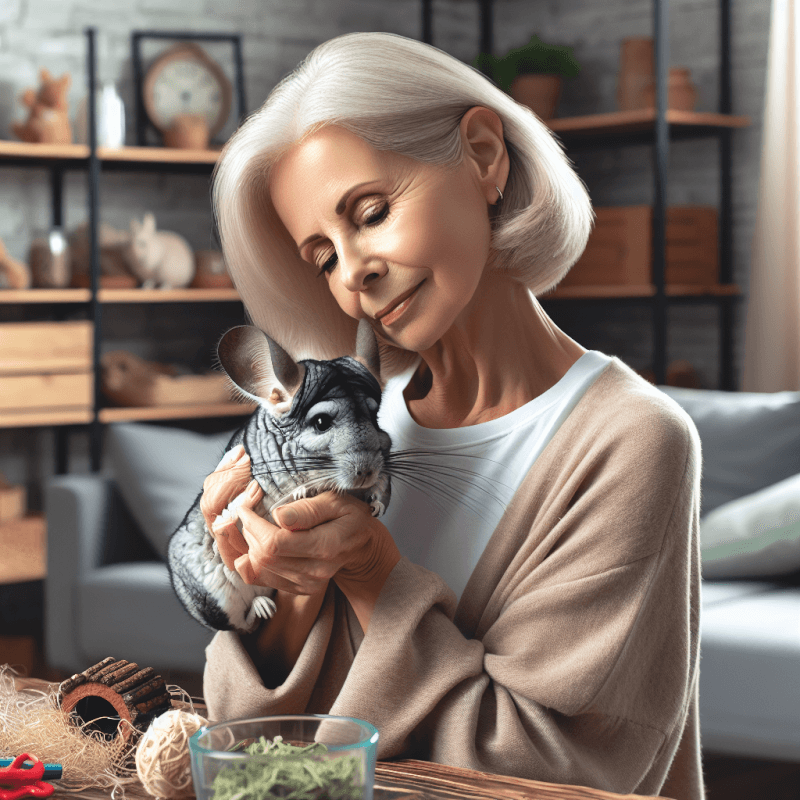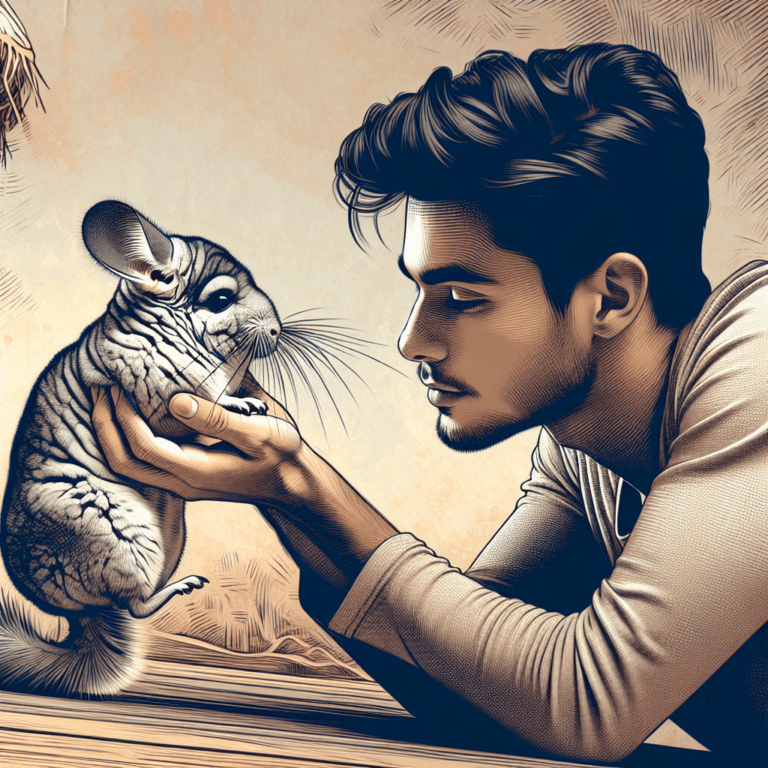So you’ve recently brought home a lovable chinchilla as a new furry friend, but now you’re wondering how to create a strong bond between the two of you. Building a close relationship with your chinchilla takes time, patience, and understanding. In this article, we will explore some simple yet effective ways to connect with your chinchilla, ensuring a long-lasting and meaningful companionship. Ready to embark on this delightful bonding adventure? Let’s get started!
Understanding Chinchilla Behavior
Observing Chinchilla Behavior
Observing your chinchilla’s behavior is an essential first step in building a bond with your furry friend. Take some time to simply watch and learn about their natural habits and tendencies. Chinchillas are known for being active and curious creatures, so observe how they move about their environment, explore their cage, and interact with toys or other chinchillas if you have multiple pets. Understanding their behavior will allow you to better anticipate their needs and tailor your interactions with them accordingly.
Ready for Cat Trivia?
Test your knowledge about cats!

Understanding Body Language
To truly connect with your chinchilla, it’s crucial to learn how to interpret their body language. Chinchillas use various postures and movements to communicate their feelings and intentions, so paying attention to these cues is key. For example, if your chinchilla is standing upright on their hind legs with their ears erect, it often means they are alert and curious. On the other hand, if they flatten their ears against their head and tuck their tail, it could indicate fear or aggression. By observing and understanding your chinchilla’s body language, you can better respond to their needs and emotions.
Recognizing Vocalizations
Chinchillas communicate not only through body language but also through vocalizations. While they may not be as vocal as some other pets, they do have a range of sounds that express their feelings. These vocalizations can include chirping, barking, or even purring. By familiarizing yourself with these sounds, you can better understand what your chinchilla is trying to communicate. For instance, a loud barking noise may indicate that your chinchilla is feeling threatened or startled. By recognizing and responding to their vocalizations, you can build a stronger connection and trust with your chinchilla.
Creating a Safe and Comfortable Environment
Providing a Spacious Cage
Chinchillas need a spacious and secure cage to thrive. Ensure your chinchilla has plenty of room to move around and engage in natural behaviors, such as hopping and climbing. Look for cages specifically designed for chinchillas with horizontal bars to allow for climbing, and avoid wire flooring that can harm their delicate feet.
Furnishing the Cage with Hideouts
Chinchillas are naturally cautious animals and appreciate having hiding spots where they can retreat to when they feel overwhelmed or anxious. Provide your chinchilla with appropriate hideouts such as tunnels or wooden huts where they can feel safe and secure.
Maintaining Optimal Temperature
Chinchillas are sensitive to temperature and thrive in cooler environments. Keep their cage in a room with a consistent temperature range of 60-70 degrees Fahrenheit (15-21 degrees Celsius). Avoid placing their cage near direct sunlight, drafts, or overly warm areas, as these can be detrimental to their health.
Ensuring Proper Ventilation
Good ventilation is essential for your chinchilla’s well-being. Ensure that their cage is in a well-ventilated area to prevent the buildup of ammonia from their urine. Providing air circulation will help maintain a healthy environment for your furry friend.
Keeping the Cage Clean
Maintaining a clean cage is crucial for the health and happiness of your chinchilla. Regularly remove any soiled bedding, uneaten food, or droppings from the cage. Provide fresh bedding and change it on a regular basis to prevent odors and bacterial growth. A clean and hygienic environment will contribute to your chinchilla’s overall well-being and make them more comfortable in their surroundings.
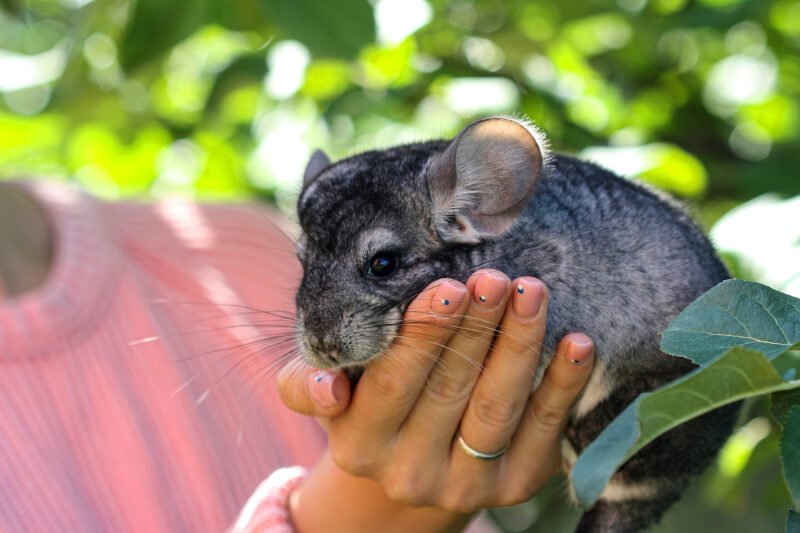
Establishing Trust and Familiarity
Give Your Chinchilla Time to Adjust
When bringing a new chinchilla home or introducing changes to their environment, give them time to adjust. Chinchillas are naturally wary of new surroundings and may need a few days or even weeks to feel comfortable. Avoid overwhelming them with too much interaction in the beginning and be patient as they acclimate to their new home.
Approaching Slowly and Calmly
Approach your chinchilla slowly and calmly to avoid startling or frightening them. Extend your hand towards them at their eye level and allow them to sniff and investigate. Avoid making sudden or jerky movements, as this can cause them to become anxious or defensive.
Using a Soft and Gentle Voice
Chinchillas respond well to a soft and gentle voice. Speak to them in a soothing tone to help them feel at ease. Avoid speaking loudly or using harsh tones, as this can scare or stress them out.
Offering Treats and Rewards
One way to build trust and familiarity with your chinchilla is through positive reinforcement. Offer your chinchilla small, healthy treats as rewards for good behavior or when they interact with you in a positive way. This will help them associate you with positive experiences and create a bond of trust.
Avoiding Sudden Movements or Loud Noises
Chinchillas are sensitive creatures and can be easily startled by sudden movements or loud noises. Avoid making any abrupt or loud sounds when you are around them. This will help create a calm and safe environment for your chinchilla and prevent unnecessary stress.
Building a Routine
Chinchillas thrive on routine, so establishing a consistent schedule for feeding, playtime, and interaction can help build a sense of familiarity and security. Stick to a daily routine as much as possible to give your chinchilla a sense of predictability and stability.
Handling Your Chinchilla
Introducing Hand Feeding
Hand feeding is a great way to create a positive association between you and your chinchilla. Offer your chinchilla a small treat from your hand, allowing them to approach and take it at their own pace. This will help them associate your hand with something pleasant and rewarding.
Gradual Approach to Touching
Gently introduce touching and petting to your chinchilla by starting with light strokes on their back or chin. Pay attention to their response and body language. If they seem comfortable and relaxed, gradually increase the duration and intensity of the touch. However, if they show signs of discomfort or try to move away, respect their boundaries and give them space.
Avoiding Squeezing or Grabbing
Chinchillas have delicate bones and should never be squeezed or grabbed. Always handle them with care, supporting their body properly and avoiding any rough handling. Any mishandling can cause injury or stress, which can damage the bond you’re trying to build with your chinchilla.
Supporting the Body Properly
When picking up or holding your chinchilla, make sure to support their body properly to avoid any risk of injury or discomfort. Place one hand underneath their body while using your other hand to support their hindquarters. This helps distribute their weight evenly and ensures a secure hold.
Building Up to Holding and Cuddling
Some chinchillas may enjoy being held and cuddled, while others may prefer to be independent. Respect your chinchilla’s preferences and build trust gradually. If your chinchilla shows signs of stress or discomfort when being held, focus on other forms of interaction that they enjoy and feel comfortable with.
Respecting Your Chinchilla’s Limits
Every chinchilla is unique, and it’s important to respect their individual limits and preferences. Pay attention to any signs of stress, fear, or discomfort, and adjust your approach accordingly. Remember, a trusting and positive bond is built on mutual respect and understanding.
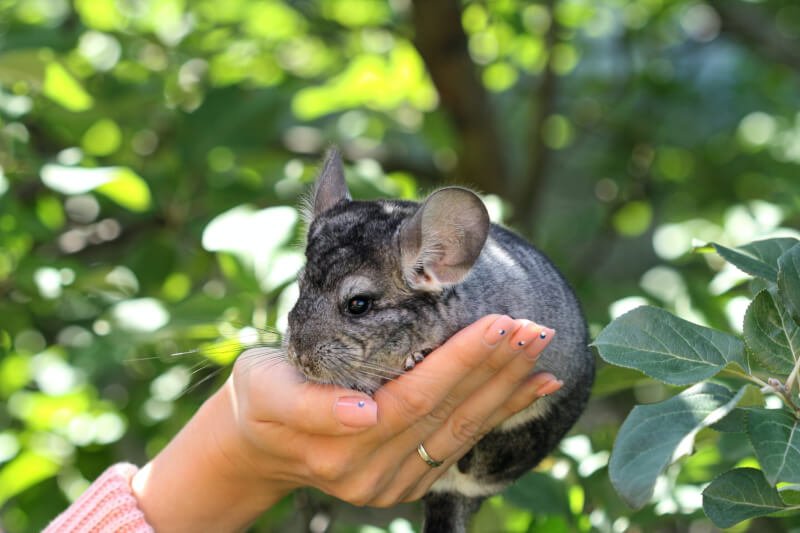
Playing and Interacting
Providing Safe Toys and Enrichment
Chinchillas are active animals and require mental and physical stimulation. Provide them with a variety of safe toys and enrichment activities to keep them entertained. Toys such as wooden blocks, chew sticks, or tunnels can satisfy their natural chewing and exploring instincts.
Offering Playtime Outside the Cage
Chinchillas also benefit from supervised playtime outside of their cage. Set up a safe and secure play area where they can exercise and explore under your watchful eye. Ensure the space is chinchilla-proofed, free from potential hazards, and inaccessible areas where they can hide or get stuck.
Supervising Interactions
When allowing your chinchilla to interact with other pets or humans, always provide close supervision. Chinchillas are small and delicate creatures, and interactions with larger animals or rough handling by humans can lead to injury. Make sure all interactions are gentle, controlled, and safe for everyone involved.
Engaging in Interactive Games
Engaging in interactive games can help strengthen the bond between you and your chinchilla. Simple activities like rolling a small ball, playing hide-and-seek with treats, or enticing them to chase a feather wand can provide mental stimulation and foster a sense of trust and enjoyment.
Using Positive Reinforcement
Reward your chinchilla’s positive behavior during playtime by offering treats or praise. This will reinforce their good behavior and encourage them to continue engaging in interactive play. Positive reinforcement is a powerful tool in building a strong bond with your chinchilla.
Building a Bond through Grooming
Introducing Brushing and Combing
Regular grooming sessions not only help maintain your chinchilla’s coat but also offer an opportunity for bonding. Start by gently introducing brushing or combing with a soft brush or specific chinchilla grooming tools. Use slow and gentle motions to avoid causing any discomfort or stress.
Monitoring Your Chinchilla’s Coat
While grooming, keep an eye out for any changes in your chinchilla’s coat. Look for signs of matting, bald patches, or skin irritations, as these can be indications of underlying health issues. Regular grooming sessions allow you to stay attentive to your chinchilla’s overall well-being.
Checking for Any Health Issues
During grooming sessions, take the opportunity to check other aspects of your chinchilla’s health. Examine their teeth for overgrowth, their eyes for any signs of discharge, and their ears for cleanliness. If you notice anything unusual or concerning, consult a veterinarian for further guidance.
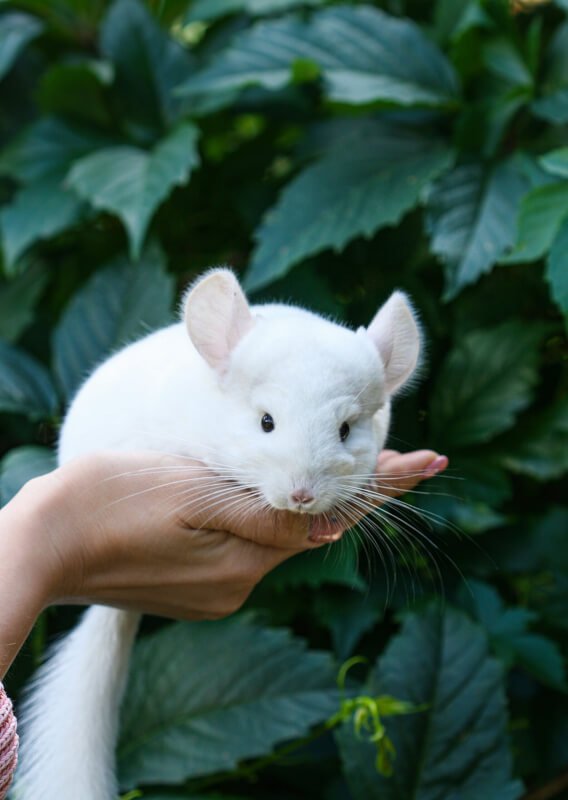
Understanding Chinchilla Preferences
Researching Chinchilla Diet
A proper diet is essential for your chinchilla’s health and well-being. Research and understand their dietary needs, which primarily consist of hay, fresh water, and chinchilla pellets. Make sure to provide high-quality hay and pellets formulated specifically for chinchillas to ensure they receive the necessary nutrients.
Providing Fresh Water and Hay
Fresh water should always be available to your chinchilla. Use a water bottle with a sipper tube to minimize the risk of contamination or spills. Additionally, hay is a vital part of their diet and should be provided in abundance to support their dental health and digestive system.
Choosing the Right Pellets
Chinchilla pellets should make up a significant portion of their diet. Opt for pellets that are specifically formulated for chinchillas, as other types of pellets may not provide the necessary nutrients. Be mindful of the amount you feed and avoid overfeeding, as obesity can lead to various health issues.
Offering Nutritious Treats
Treats can be used as rewards during training or as occasional snacks. Choose healthier options such as small pieces of fruits or vegetables that are safe for chinchillas. However, keep in mind that treats should only make up a small percentage of their overall diet, as excessive or improper treats can lead to digestive problems.
Exploring Chinchilla-Safe Foods
Certain fruits and vegetables can be safely offered to chinchillas as part of a balanced diet. Research and familiarize yourself with chinchilla-safe foods, as some fruits and vegetables can be harmful or toxic to them. Examples of safe options include apple slices, carrots, and leafy greens like spinach or kale.
Avoiding Harmful Foods
There are several foods that should be strictly avoided as they can be harmful or toxic to chinchillas. These include chocolate, caffeine, onions, garlic, and high-sugar or high-fat foods. Educate yourself about the potential dangers of certain foods and ensure your chinchilla’s diet is free from any harmful substances.
Creating a Bond with Multiple Chinchillas
Introducing Chinchillas Slowly
When introducing multiple chinchillas, it is crucial to do so gradually. Chinchillas are known to be territorial, and sudden introductions can lead to aggression or stress. Start by placing their cages near each other so they can become familiar with each other’s scents before proceeding to monitored interactions.
Providing Multiple Hiding Spots
When housing multiple chinchillas together, it’s important to offer multiple hiding spots within their shared cage. This allows each chinchilla to have their own space and retreat when they need some alone time or want to establish their territory.
Observing Interactions
As you gradually introduce chinchillas to each other, closely observe their interactions. Look for signs of aggression, such as chasing, biting, or mounting. It’s normal for chinchillas to establish a hierarchy when forming a group, but if any behavior becomes aggressive or results in injury, separate the chinchillas and consult a veterinarian or an experienced chinchilla owner for guidance.
Ensuring Sufficient Resources
When housing multiple chinchillas together, ensure that there are enough resources for all. This includes providing multiple food bowls, water bottles, and hiding spots. A scarcity of resources can lead to competition and possible aggression between chinchillas.
Monitoring for Signs of Aggression
Ongoing monitoring is essential when keeping multiple chinchillas together. Watch for any signs of aggression, changes in behavior, or noticeable injuries. If any conflicts or aggression persist, it may be necessary to separate the chinchillas and provide individual housing arrangements.

Seeking Professional Advice
Consulting a Veterinarian
If you have any concerns about your chinchilla’s health, behavior, or overall well-being, it’s important to consult with a veterinarian who has experience with exotic pets, specifically chinchillas. They can provide expert advice, perform necessary health checks, and address any underlying medical issues that may affect your chinchilla’s bonding process.
Visiting Chinchilla Forums or Support Groups
Chinchilla forums and support groups can be valuable resources for chinchilla owners seeking advice and guidance from experienced individuals. These online communities can provide valuable insights into bonding techniques, behavior management, and general chinchilla care. Engaging with fellow chinchilla enthusiasts can also offer emotional support and help you feel more confident in your journey of bonding with your chinchilla.
Contacting a Chinchilla Rescue Organization
If you are struggling to bond with your chinchilla or facing challenging circumstances, such as a rescued chinchilla with a traumatic past, contacting a chinchilla rescue organization can provide additional support and guidance. These organizations have a wealth of experience in rehabilitating and socializing chinchillas, and they can offer valuable advice tailored to your specific situation.
Final Thoughts
Patience and Consistency are Key
Building a strong bond with your chinchilla takes time, patience, and consistency. Every chinchilla is unique, so the process may vary. Be patient with your furry friend, respect their boundaries, and maintain a consistent routine to foster a deeper connection.
Understanding Your Chinchilla’s Individual Personality
Just like humans, chinchillas have their own unique personalities. Some may be more outgoing and affectionate, while others may be more reserved and independent. Take the time to understand your chinchilla’s individual preferences and adjust your interactions accordingly. Building a bond requires recognizing and respecting their individuality.
Enjoy the Journey of Bonding
Remember to enjoy the journey of bonding with your chinchilla. The process of building trust, establishing a connection, and strengthening your bond can be incredibly rewarding. Take pleasure in the small victories and celebrate the milestones as you develop a lifelong friendship with your chinchilla.
Building a Lifelong Friendship
By following these tips and investing time and effort into understanding and connecting with your chinchilla, you can build a lifelong friendship. Cherish the bond you create and continue to nurture it through love, care, and positive interactions. Your chinchilla will reward you with their unique personality and endless affection.
